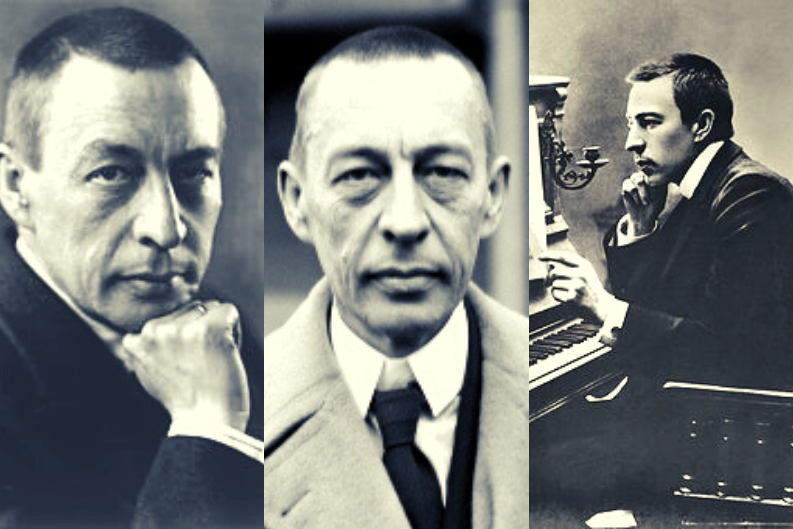
Sergei Rachmaninoff’s legendary piano performances, lavish symphonic writing and awe-inspiring vocal works sealed his place as one of the most celebrated 20th-century composers. This year marks Rachmaninoff's 150th birth anniversary and CPR Classical staff share their favorite and must-hear pieces.
Tune in to CPR Classical Saturday, April 1 for on-air programming from our hosts, including the music found below. Want some Rachmaninoff right now? You can hear all of these pieces instantly (and more!) in our newest playlist "Rachmaninoff 150" on Spotify.

"Liebesleid" — Jessie Jacobs
"I watched 'Your Lie in April' a couple of years ago — a show about a young concert pianist trying to overcome the past and play again — and I still haven’t recovered from the overwhelming emotions it stirred in me. It’s the reason I am now so attached to Rachmaninoff’s arrangement of Kreisler's 'Liebesleid,' a piece featured in the show. It’s haunting and overwhelming and hopeful all at once. It never fails to give me chills and melt my heart."

"Symphony No. 2" — Jean Inaba
"Lush romanticism... a work chock-full of beautiful melodies. Rachmaninoff takes his time spinning out all his musical ideas. It's a real treat for listeners! It's also hugely rewarding for orchestra players over the course of this expansive symphony... lasts about an hour!"

"Bogoroditse Devo" from the All-Night Vigil — Patty Painter-Wakefield
"The entire 'All-Night Vigil’ ('Vespers') is a beautiful a cappella choral work (and reportedly one of Rachmaninoff's own favorites of his compositions!) This particular part, 'Bogoroditse Devo,' or 'Ave Maria' in Latin, has special memories for me. For a number of years, I was part of a church that started up a small choir dedicated to a cappella music. Learning Russian was a challenge, but rewarding. The most thrilling part comes as just the upper parts rise in a crescendo — and then the basses join back in. Goosebumps moment!"

"Daisies" — Matt Weesner
"I do love the big romantic symphonies, but I'm also drawn to Rachmaninoff's piano miniatures. I learned a few while taking piano lessons, and I still go back to them. So much of what we love about his big orchestral pieces is here in these little piano pieces, too. Especially the two-minute Romance called "Daisies." This piece (written in 1916) looks ahead to sounds we now associate with jazz. A must-hear: Rachmaninoff's own recording from March 18, 1940 (check out those last few chords!)"

"Rhapsody on a Theme of Paganini" — Kabin Thomas
"First off, it has a lovely tuba part, which is always important to me. Plus, the piano is miraculously web-spun inside, outside and all around the orchestration. The 'red dot' is the melody, of course, which gets to be shared by the soloist and the orchestra. A true exemplar of melodic diversity, harmonic equity and rhythmic inclusion, between orchestra and soloist, from top to tail."

"Vocalise" — Monika Vischer
"It's one of the most popular songs ever written but doesn't have any words. It's the last of 14 songs and often the first of Rachmaninoff's works listeners hear. His gift for melody permeates his music, captured in this little nugget of excruciating beauty whether sung or played on almost any instrument."

"Sergei Rachmaninoff experienced a surge of success, especially through the 1930s. It was also an unusually difficult time for the Russian composer. He endured criticism from the Soviet Union for endorsing an anti-Soviet manifesto. And he had to abandon his beautiful Villa Senar on Lake Lucerne because of growing political tensions in Europe. But in America, Rachmaninoff continued to enjoy many performances of his works to great enthusiasm up until he died just days shy of his 70th birthday. The "Symphonic Dances" were his last major work, exuding no lack of profound finality." — Monika Vischer

"Pâques" ("Easter"), from Suite No. 1 for Two Pianos — Scott Clemens
"Rachmaninoff makes use of two pianos to evoke the clangor of massive bells. It's as if he's recalling a scene from his childhood, where he wakes up on Easter Sunday and the hum of the city is nothing but pealing bells and liturgical chant. 'All my life I have taken pleasure in the differing moods and music of gladly chiming and mournfully tolling bells. This love for bells is inherent in every Russian,' the composer once wrote."

"Isle of the Dead" — Karla Walker
"Classical music is full of pieces that sound spooky or scary. Making music sound eerie is a much harder concept to get at but Rachmaninoff nails it in 'Isle of the Dead.' It opens with a tympani and strings lifting and sinking, mimicking the oarsman rowing his cargo to the Isle of the Dead in Arnold Böcklin's famous painting by the same name. Rachmaninoff had spent two years trying to find inspiration for a tone poem and found it when he saw a black-and-white reproduction of the painting. He later said, 'If I had seen first the original, I, probably, would have not written my Isle of the Dead. I like it in black and white.'"
Hear CPR Classical by clicking “Listen Live” at the top of this website, or download the Colorado Public Radio app. Listen on your radio to CPR Classical at 88.1 FM in Denver, at radio signals around Colorado. You can also tell your smart speaker to “Play CPR Classical."









